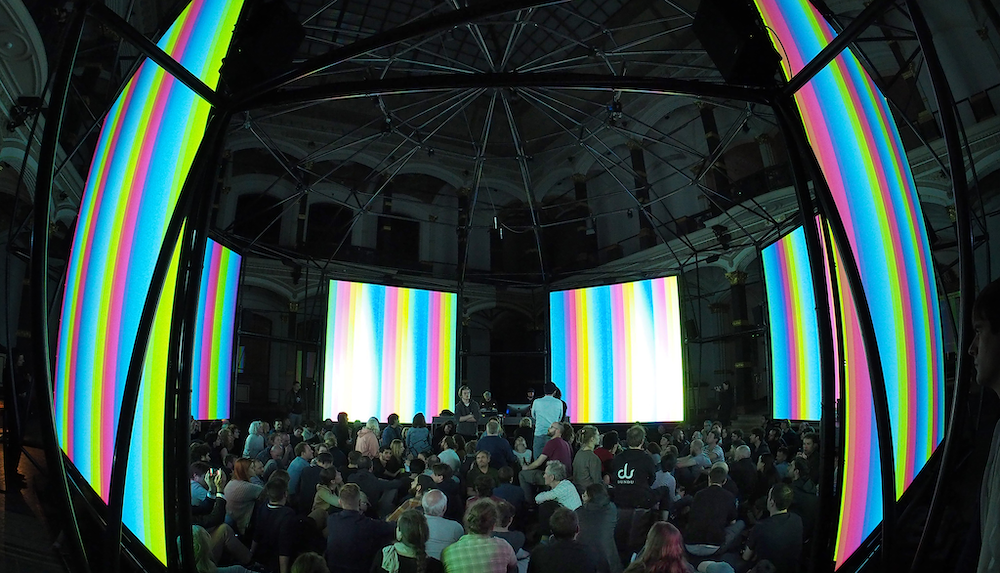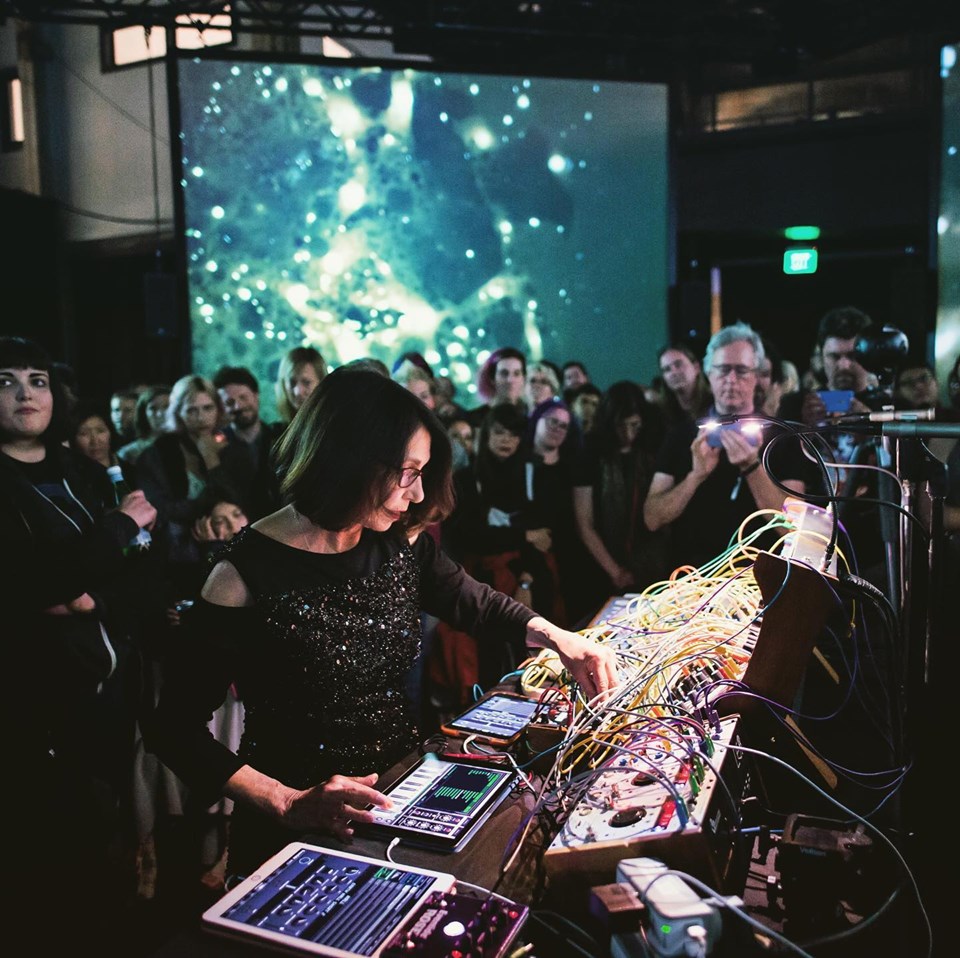Do not be afraid; our fate cannot be taken from us; it is a gift. —Dante, The Inferno.
One must imagine Sisyphus happy. —Camus, The Myth of Sisyphus.
Pledge allegiance to the world’s most powerful computer/ What will it take to make you capitulate? —Grimes, “We Appreciate Power.”
I mostly thought of these lines as I watched 12 volunteers in shapeless brown flight suits get strapped into the pneumatic exoskeletons dangling by power cords from the ceiling of Gray Area in the Mission. They looked like concept art for a Matrix sequel, or instruments of torture from some runaway cyberpunk dystopia. And perhaps this is the point: In “Inferno,” an interactive installation by Louis-Philippe Demers and Bill Vorn, robots have literally taken over and they are making us dance.
Part of the Gray Area Festival, which started last Thursday and continued through the weekend, “Inferno” is a classic example of the kinds of hybridization the foundation is interested in, the areas where art and technology can dissect or superimpose over each other, revealing; in their own words, forward-looking approaches to advancing culture and common good.
A combination of robotics, haptics, light design, and industrial music, each part of this performance (or piece, the distinction is not clear) seems to indicate a separate kind of worst case scenario we could experience as a species—or indeed, how technology could be leveraged to enable us to experience multiple, integrated varieties of hell all at once.
There is hell as Camus imagined it, as an eternal torment by some repetitive and mandatory activity. Though the dance certainly looked repetitive and almost laborious, some of the volunteers, guided by the hissing hydraulics, seemed to be happy under the command of their new robot overlords. The newly minted cyborgs improvised their own footwork to sync up with the jerky, nonstop movements of their arms, a kind of mandatory duet that more resembled someone, say, walking across a river of boiling pitch or evading the talons of befanged harpies than just enjoying themselves on a Saturday night.
There is then hell as Grimes imagines (or celebrates) it, which is one of total technological control in which we are willing and perhaps even enthusiastic participants. The programmed moves, as a byproduct of the mechanics of the skeleton used to produce them, resembled a uniformed military march or training exercise, as though participants’ bodies had been deputized to serve as unwilling participants in some cybernetic war. The implications are obvious: what if an entire army, hacked by trolls, stopped on the field of battle and just started flossing?
Help us save local journalism!
Every tax-deductible donation helps us grow to cover the issues that mean the most to our community. Become a 48 Hills Hero and support the only daily progressive news source in the Bay Area.
Finally, there is hell as Dante himself imagined it, concentric circles of worsening sin, punished for your deeds with some twisted reversal of your crime for all eternity in a cohort of your peers (for what crime, therefore, is the punishment dancing? The Hypocrites in the eighth circle of Hell are forced to walk around a single track for all eternity, wearing gleaming robes that restrict their movement. Are we the hypocrites?)

While the Inferno raged on in the city, down by the waterfront at Pier 70 the Institute for Sound and Music, Berlin presented the Hexadome, a thankfully less pessimistic but no less immersive series of audiovisual works by artists like Thom Yorke and Ben Frost. Images were projected on six screens surrounding the audience, who may choose to look in any direction. The works were in most cases so abstract they defy any real kind of analysis. (To put it another way, you are probably going to enjoy these works best if you are at least a little high.)
Some scenes resembled physically impossible landscapes or sites of worship for some future digital religion. Some others like what Salvador Dali might produce while designing a screensaver for Windows 97 after having discovered vaporwave. Familiar forms and patterns are rendered unfamiliar. By squinting, tapping into your inner pareidolic intuition, you can glimpse changing lights projected onto ultra thin membranes, and crystals scattering light in obvious defiance of natural optical law, a focus on microscopic constructs, the physics of scale, cellular automata, an entire universe of warped color and light discoverable in the first 12 nanoseconds of a VHS tape.
It is a wonderful tool for activating the imagination. Sonically, the bulk of the pieces seemed focused on a materials science of sound design, so to speak—imagining not only the sound itself but the object that might have actually produced it. (Hexadome runs through August 3.)
The bulk of the festival over the weekend concentrated mainly on talks running the gamut from artists and intellectuals to curators and historians from across the globe, like Monica Bello. She is the current artistic director at CERN, and showcased artists like Ryoji Ikeda—who designed a light display based on the infamous interference pattern of the double slit experiment—and others who built sculptural artifacts out of the wreckage of outdated LHC modules. Another talk focused on solving global food insecurity though technopagan theories of Gaian responsibility wherein augmented reality teaches children to garden (worth a shot).

The highlight of the weekend was obviously electronic music legend Suzanne Ciani, who presented her new work Under the Electric Sea. The piece is a live analog performance on a Buchla 200E, a machine which more resembles the command module of the Apollo mission than a musical instrument.
The diva of the diode humbly stood in line for the bathrooms with everyone else, then took the stage in front of her byzantine instrument, situated in the dead center of the Hexadome (in a visual collaboration with AudeRrose), with the audience on all sides watching her every move with rapt attention. In this setup, musical signals are physically rerouted through different parts of the hardware circuitry using changeable cables, where every module that the signal is directed through transforms the sound at the output in some way.
The adept performer must have some knowledge of the transfer function of each of these modules a priori in order to generate the kinds of sounds they specifically want for a certain piece by patching on the fly. Nobody knows how to tease such intricate soundscapes out of this kind of hardware like Ciani, who has been innovating the form since the ’60s.
Pure and corrupted sawtooth waves rose with an almost physical heft, practically leaving dents as they pinged off the corrugated metal roof. It was a somewhat more purposefully digital sound than Ciani is famous for. Single notes vibrate and then plunge octaves, structure and rhythm appearing and then collapsing again, Ciani proving that she has not retreated one centimeter from the experimental and radical, and is perhaps now doubling down.
The final day consisted of workshops, hands-on activities allowing those in attendance to explore this interface of art and technology for themselves. The workshop I attended, on the topic of homebrewed synthesizer design, suffered a bit from its ambition, which was to ensure that every random person who signed up (most with no technical background whatever) would walk out with a functional synthesizer they had soldered together themselves, from a kit.
This resulted in the instructor unfortunately having to focus far more time on the finer points of prototype board soldering technique then the more interesting theory of how or why a synthesizer is built this way, what the individual components are for, the electronic theory of why these modules were working at all. (Which, by some technical miracle, most were by the end of the session.) But really, nothing fires up the imagination like completing a project like this with your own two hands, switching it on, and listening to the sounds that come rocketing out. Isn’t that what we all came here for, after all?





